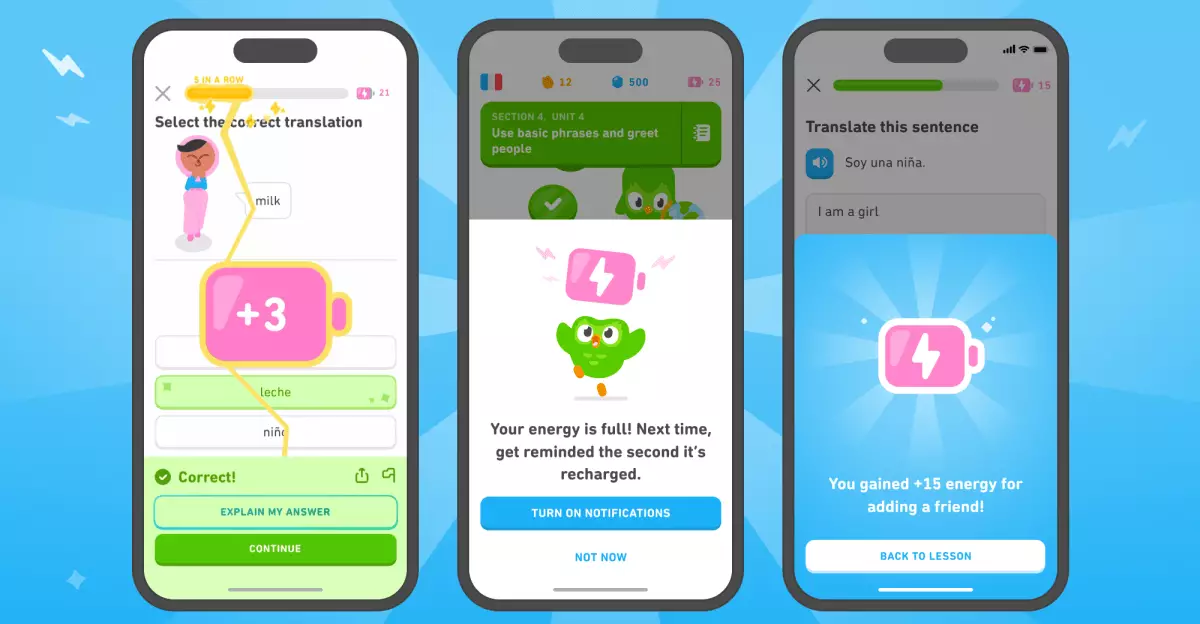Duolingo, the widely popular language acquisition app, has decided to overhaul its foundational approach to user engagement and motivation. Traditionally, users navigated their language learning journey with a heart system designed to penalize errors, marking each mistake with a loss of hearts—essentially discouraging risk-taking and exploration. However, in a groundbreaking move poised to uplift user experience, Duolingo is introducing an “energy” system, aimed at replacing the outdated punitive framework with an engaging, motivational structure. This transition reflects a larger trend in educational technology, where gamification techniques harness motivation, allowing learners to feel encouraged rather than demoralized by missteps.
The rationale behind this significant change isn’t just to address user complaints; it reflects an understanding of how people learn. Mistakes are an invaluable part of the learning process, and penalizing users for making them can create anxiety and disinterest. By shifting to an energy-based system, Duolingo aims to foster a more forgiving and supportive learning atmosphere. This can potentially lead to higher engagement, as users will feel empowered to attempt exercises without the fear of immediate and visible repercussions.
Understanding the Energy System
The forthcoming energy mechanic replaces the former heart system with a more nuanced approach. Each user starts with a full energy bar containing 25 units, with each exercise costing a single unit of energy. By letting users regain energy at a random rate for consecutively completed lessons, Duolingo smartly encourages smooth learning without making mistakes feel like dead ends. This innovative format signals an important departure in educational philosophy, spotlighting the virtue of persistence and practice while downplaying the negativity associated with errors.
Highlighting this point, Moses Wayne, a senior staff engineer at Duolingo, mentions that this new approach allows users to focus on the correct aspects of their learning rather than dwelling on failures. The added bonus of regaining energy for streaks of correct answers fosters an atmosphere of success within the app, which can be far more motivating for learners who may otherwise feel defeated after a few errors.
A Gamified Educational Experience
The introduction of energy not only reshapes how users interact with the app but also enhances its gamified essence. Users are incentivized to push forward through content, reaping rewards for their engagement and improving upon their skills in a fun way. Additionally, Duolingo’s system retains the option to purchase additional energy using the app’s currency, Gems, offering a financial incentive that many users are willing to pay for an uninterrupted learning experience. The subscription model, allowing unlimited energy for Super Duolingo and Duolingo Max customers, further illustrates how Duolingo seeks to maintain revenue streams while providing enriched experiences.
Critics of the app might argue that relying heavily on gamification can dilute the educational essence of language learning, turning it into a numbers game rather than a serious endeavor. Yet, this perspective overlooks the fundamental realities of user engagement in digital learning environments today. In a world where attention spans are fleeting, gamification can serve as the bridge that engages learners and keeps them coming back for more—making language acquisition an enjoyable, rather than tedious, task.
The Larger Implications of Change
This transformation comes at a time when the educational industry is seeing a surge in artificial intelligence integration. Duolingo’s commitment to being “AI-first” is another crucial component of their strategy. With AI capabilities to expand language courses and customize learning paths for users, Duolingo is not just adapting to the contemporary educational landscape but redefining it.
The overall shift to an energy system and the intention to employ AI in their offerings positions Duolingo uniquely within the market. It raises the expectation for other educational platforms to innovate and rethink traditional learning models that might stifle creativity and engagement. As we keep an eye on how these changes affect user behaviors and success rates, it becomes clear that in the realm of learning apps, Duolingo is leading the way—challenging conventional norms with exciting new methodologies.
In essence, while change can be daunting, Duolingo’s refreshed approach could herald a new era for language learning, making it not just a necessity but a joyous activity.


Leave a Reply